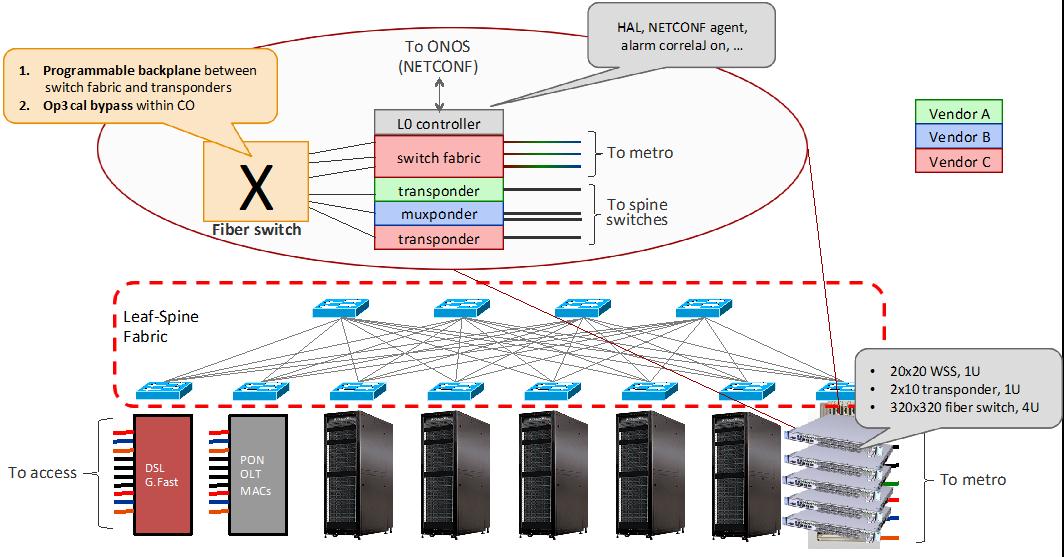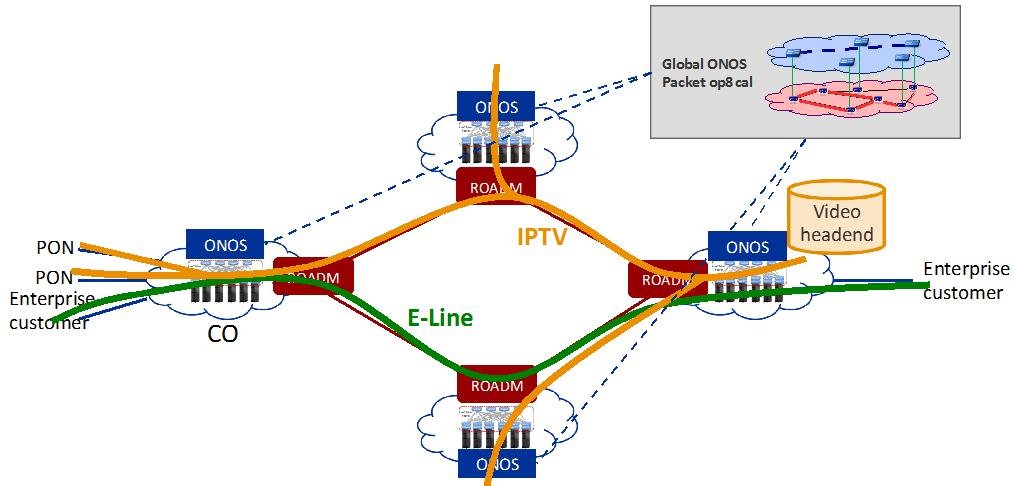Rethinking Metro Networks
Rethinking Metro Networks
Marc De Leenheer, Open Networking Lab; and Tom Tofigh, AT&T
Abstract: To achieve network-wide programmability and observability, open source and vendor-agnostic interfaces are critical. We discuss the re-design of the metro network, demonstrate practical and scalable operational models, and introduce a disaggregated ROADM architecture.
1. Introduction
Metro networks form a key component of service providers’ complex infrastructure. A metro network connects the Central Offices in a metro area and serves as an aggregation network between the access networks and the wide area network. Innovating in the metro is challenging due to the tight interworking between vendor equipment and the control functions. Every vendor offers their own implementation of popular metro services, and requires the service provider to acquire and operate a vertically integrated set of network elements that span the whole metro. This work tries to enable service providers to build their infrastructure using white boxes (both packet and optical), open source software defined networking (SDN) platforms, and a set of network control and management applications. Our approach avoids vendor lock-in and enables service providers, partners and vendors to rapidly innovate on this infrastructure.
This work is in the context of CORD: Central Office Re-architected as a Datacenter [1]. The goal of CORD is to bring the economies of a datacenter and the agility of the cloud to telco service providers. The metro network design builds on this approach in three significant ways: (1) it uses a single SDN control plane built using ONOS to create a converged packet-optical network for the metro area; (2) it demonstrates several innovative network services on this converged network; and (3) it shows how one can build even Reconfigurable Optical Add Drop Multiplexers (ROADM) as white boxes using a set of merchant optical building blocks.
2. SDN Control Plane with Open Source Network Operating System (ONOS)
ONOS [2] is an open-source SDN OS architected to meet the stringent availability, scalability and performance demands of service provider networks. It was built from the ground up with a distributed architecture and introduces innovative state management techniques. ONOS championed the intent abstraction, which frees application developers from the need to specify and control low-level parameters, leaving them for the OS to optimize as network conditions change. Additionally, ONOS offers a converged topology abstraction, in which multiple network layers and technologies are presented as a single logical graph. Finally, ONOS comes with a built-in multi-layer path computation element (PCE), as well as a modular system design allowing external PCEs to be plugged in dynamically.
Figure 1 – (a) Central Office Re-architected as a Datacenter consists of a leaf-spine IP fabric, servers for computational and storage resources, I/O blocks for virtualized access technologies G.fast and GPON, and disaggregated ROADM.
(b) Metro network consisting of Central Offices (CO) each with a local ONOS controller. The global controller maintains the converged packet/optical model and runs advanced applications in support of enterprise connectivity and video distribution.
ONOS’ southbound interface forms a layer of abstraction to handle the forwarding, monitoring and configuration of network elements such as devices, links, and hosts, ensuring no protocol-specific or vendor-proprietary logic leaks into the distributed core. Today ONOS supports a wide range of protocols such as OpenFlow, Network Configuration Protocol (NETCONF), PCE Protocol, Simple Network Management Protocol (SNMP), and several Transaction Language 1 (TL1) implementations from multiple vendors.
3. Metro Services
ONOS has native support for bandwidth on-demand, calendaring and automatic restoration in the optical layer. These features form the foundation to support two of the most popular metro services, which both require tight coupling of packet and optical layer control.
- Enterprise connectivity has been standardized by the Metro Ethernet Forum, which defined services such as E-Line, E-LAN and E-Tree [3]. Most stakeholders have eagerly adopted these Layer-2 VPN solutions.
- Video distribution is supported in two ways. First, live TV is delivered to residential users over multicast. We have added support for Protocol Independent Multicast (PIM) and Internet Group Management Protocol (IGMP) to allow white box packet switches to function as multicast routers. Second, video on-demand services rely on optimized mapping onto available optical capacity.
4. Disaggregated ROADM
Vertical integration of networking hardware has been acknowledged time and again as a way to achieve vendor lock-in. Our goal is to open the network to those that own and operate it, and to achieve programmability and observability, ultimately leading to zero-touch configuration and autonomic networks that can detect and repair themselves without human intervention. Realizing these goals require decomposing the optical devices into functional blocks [4], and defining generic interfaces that work across vendor and technology-specific implementations. Disaggregation of a chassis-based design into commodity components also allows service providers to rightsize their infrastructure and grow as needed. Figure 1a shows the disaggregated ROADM model as envisioned inside a CORD deployment.
- The switching fabric forms the heart of the ROADM; it is based on wavelength selective switches, along with necessary amplifiers and monitoring elements.
- The trans/mux/flexponder becomes a separate component in our model. In the early stages, identical (or at least from the same vendor) transponders will be required on both ends of a connection. Multi-vendor data plane compatibility will eventually become possible using this model, based on shared open standards for common DSP functions such as error correction, modulation, clock recovery, etc.
- Disaggregating traditional ROADM designs implies the backplane is lost. It can be recreated by manual interconnection of the different transponders and switch fabric. The loss of flexibility can be overcome using a fiber switch; these micro-electro-mechanical or MEMS-based network elements are available in huge switch matrices (320x320), have acceptable loss figures (~3.5dB), and switching speeds in the order of milliseconds.
- The L0 controller exists for several reasons. First, without it, disaggregated components would need to implement a full TCP/IP stack to offer protocol support such as NETCONF. Second, the L0 controller can easily be deployed on x86 hardware and scale to many hundreds of such components. Third, alarm correlation is critical to off-load work away from the local central office controller.
All of these components are rapidly becoming commercially available, and are available in convenient 1U through 4U form factors. Finally, note that the metro network is the ideal candidate for disaggregating packet/optical infrastructure. Indeed, the distances involved are reasonable (tens of km), bandwidth levels are typically just below the state of the art (i.e., some commoditization has already taken place on the hardware), and optical impairments are not as challenging as compared to, e.g., the wide area network.
5. Conclusion
We presented a re-design of the metro network based on SDN control of converged packet optical network (realized using open source ONOS), a set of innovative metro services, and disaggregated ROADM architecture. We are building a proof of concept of our approach.
6. References
[1] A. Al-Shabibi and L. Peterson, “CORD: Central Office Re-architected as a Datacenter,” OpenStack Summit 2015.
[2] P. Berde, et al., “ONOS: Towards an Open, Distributed SDN OS,” HotSDN 2014.
[3] R. Santitoro, “Metro Ethernet Services – A Technical Overview”, Metro Ethernet Forum, 2003.
[4] M. Birk, et al., “AT&T’s direction towards a Whitebox ROADM,” Open Networking Summit 2015.
 Marc De Leenheer is a Member of Technical Staff at ON.Lab, a non-profit organization that is building the key open source tools for software defined networking. Marc leads the IP/optical optical activities, is the maintainer of the OVX network virtualization platform, and oversees its integration into the OpenStack cloud platform. He received the PhD degree in computer science from Ghent University, Belgium in 2008, followed by post-doctoral stays at the University of California Davis and Stanford University.
Marc De Leenheer is a Member of Technical Staff at ON.Lab, a non-profit organization that is building the key open source tools for software defined networking. Marc leads the IP/optical optical activities, is the maintainer of the OVX network virtualization platform, and oversees its integration into the OpenStack cloud platform. He received the PhD degree in computer science from Ghent University, Belgium in 2008, followed by post-doctoral stays at the University of California Davis and Stanford University.
 Tom Tofigh is currently a Principal Member of Technical Staff in the AT&T’s Domain 2.0 architecture and planning Labs at AT&T. Tom has been responsible for planning and implementation of large-scale telecommunications equipment. He has extensive experience that spans across many disciplines including emerging mobility networks, switches, enhanced protocols, cross layer design, smart devices, and chip designs. Products introduced include innovative solutions for the mobile devices, switches, platforms, and QOS mechanisms. Tom is currently active member of ON.Lab representing AT&T for implementation of open source solutions for SDN/NFV.
Tom Tofigh is currently a Principal Member of Technical Staff in the AT&T’s Domain 2.0 architecture and planning Labs at AT&T. Tom has been responsible for planning and implementation of large-scale telecommunications equipment. He has extensive experience that spans across many disciplines including emerging mobility networks, switches, enhanced protocols, cross layer design, smart devices, and chip designs. Products introduced include innovative solutions for the mobile devices, switches, platforms, and QOS mechanisms. Tom is currently active member of ON.Lab representing AT&T for implementation of open source solutions for SDN/NFV.
Editor:
 Chris Hrivnak is a senior member of the Institute of Electrical and Electronic Engineers (IEEE) and IEEE Photonics Society. He is also a member of the IEEE Cloud Computing Community, IEEE Life Sciences Community, IEEE Smart Grid Community, the IEEE Software Defined Networks (SDN) Community, IEEE Internet of Things (IoT) Technical Community and the IEEE Internet Technology Policy Community.
Chris Hrivnak is a senior member of the Institute of Electrical and Electronic Engineers (IEEE) and IEEE Photonics Society. He is also a member of the IEEE Cloud Computing Community, IEEE Life Sciences Community, IEEE Smart Grid Community, the IEEE Software Defined Networks (SDN) Community, IEEE Internet of Things (IoT) Technical Community and the IEEE Internet Technology Policy Community.
SDN in the Cable Access Network
SDN in the Cable Access Network
Jeff Finkelstein, Executive Director of Network Strategy, Cox Communications
Background
With a Compound Annual Growth Rate approximately (CAGR) of 50% over the past few years we may extrapolate what our network consumption will become in the next ten years. At this pace we will outgrow capacity within cable TV head-end facilities. This will cause an increase in complexity, cost and operational impacts as we work to meet customer bandwidth demand. As service providers cable operators are concerned with managing the operational impact and cost associated with this dramatic increase in network requirements.
As part of looking at a Network 2025 view, we will focus on three key technology transformations that will help us make decisions along the way and provide a north star for optimizing our network. These three choices are:
- Software Based Networking commonly called Software Defined Networking (SDN);
- New access technologies increasing the capacity on existing and new network deployments;
- Virtualization techniques to reduce the amount of equipment needed to provide services and manage network components.
In this article I will focus on the first item, Software Based Networking.
Software Based Networking
When discussing software based networking I break it down into three key segments: Management, Control and Data planes.
The Management plane is how we manage the devices and services in the network. Common technologies include XCONF, SNMP, TR-069 and NETCONF as mechanisms for managing, along with languages for defining the management data constructs like Command Line Interface (CLI), YANG or JSON.
The Control plane defines how network elements are controlled, using technologies like SDN. SDN creates a software programmable network reaching from customer premise to data center, allowing dynamic provisioning of devices. It improves automation by using common APIs abstracting the underlying network from the OSS/BSS system, and provides a mechanism for rapid deployment of new services.
The Data plane is the physical and logical path taken by information and data packets as they move through the network. The Control plane allows the SDN controller to define a path for packets using protocols linked into the forwarding plane on the network devices, whether physical or virtual.
Software Based Networking is the sum of the parts allowing creation of dynamic virtual networks and services using well-defined protocols.
Application to the Cable Provider Network
From the beginnings of DOCSIS deployments in the late 1990s to today, whenever new capacity was needed in either the access, metro or backbone networks we were required to add specialized hardware to provide it. If we needed more capacity in the access network, we may have added more DOCSIS channels and/or performed a node split, dividing the customers into multiple service groups. At a 50% growth rate this works for a time, but we will eventually need to follow the same logic path again in 18-24 months.
The Hybrid Fiber Coax (HFC) plant has a long useful life and is capable of significant amounts of bandwidth, but we are limited by: silicon availability; linearity of amplifiers; frequency response of the cable itself; and many more constraints not specific to cable but common among outside plant deployments of broadband technologies. We need a better way to optimize the entire network to meet the capacity demand of our users.
Software Defined Networking is a key component for future growth within the broadband system. By leveraging the abstraction of the access network and embedding higher cognitive functions into SDN controllers we are able to have applications make decisions on network optimizations with no a priori knowledge of the physical network infrastructure.
The SDN controller may control not only the traditional network equipment such as backbone and metro routers, switches, and photonic layer devices, but customer premise equipment itself to direct traffic flows via optimal paths. In future home networks when there are hundreds to thousands of Internet of Things (IoT) equipment ranging from home automation, home security, sensors, and appliances, the SDN controller may control the in-home network itself by providing a multi-homed network to maximize connectivity for those services our customers will rely on. The methods defined are not limited to the DOCSIS network, they may be applied to any access networking technologies from DOCSIS, to PON, Wi-Fi, millimeter wave, LTE and 5G.
Legacy Device Support
Equipment that is deployed in the access network has a long life in the consumer’s home and outside plant. By taking advantage of abstraction we may take the SDN controller commands and convert that into commands understood by legacy devices. Many support SNMP and TR-069, while others rely on CLI to be configured.
Using a network services orchestrator to act on behalf of the legacy devices allows their inclusion in the future network and provides a way to optimize capital expenditures over the next 10 years as we move toward the future network state.
SDN for Virtualized Services
Virtualizing services traditionally provided by physical hardware in the home network is a popular topic for conferences, papers and magazines. There are conferences dedicated to Network Function Virtualization (NFV) as a way to solve the hardware based cycle of deploying new services. While NFV provides a method for creating network services in the cloud, we still need to get the traffic to them.
Using SDN as the way to route traffic to virtual network functions provides an opportunity to optimize the underlying network configuration in real-time. The following is an example of one way to accomplish this:
- Consumer device comes on-line and sends a “wake-up” message to the management controller (MC);
- The MC looks up the device in the customer catalog and determines what services are available to the customer;
- The MC communicates with the SDN controller (SC) to determine where the services are located;
- The SC communicates with the NFV controller (NC) notifying it that the consumer device is online and ready to transmit;
- The NC looks up the services in the available product catalog and notifies the NFV orchestrator (NO) of a need for those services;
- The NO finds available compute, network and storage resources to meet the needs of the consumer and passes the information back up to the NC;
- The NC creates the Service Function Chain (SFC) for the requested services and passes the entry point to the SC;
- The SC computes the optimal path for the consumer devices of the SFC;
- The consumer device sends data to the SFC entry point for transit through the virtual network.
Conclusion
Software Based Networking and Software Defined Networking are both in a state of evolution. With each new pass through the technologies we learn more about the applicability of each to our network growth and services planning. By leveraging these technologies, we will be capable of optimizing and automating our networks for current and future services, freeing our engineers to focus on the customer.
 Jeff Finkelstein is the Executive Director of Network Strategy at Cox Communications in Atlanta, Georgia. He has been part of the engineering organization at Cox since 2002, and led the team responsible for the deployment of DOCSIS technologies, from DOCSIS 1.0 to DOCSIS 3.0. Jeff and team have made significant contributions to the access network design and deployments at Cox, and he now has the new role of being responsible for future technology planning of backbone, metro, access, and home networks. His current focus is on defining the 10 year network strategy for Cox and leading the effort of moving to organization towards that vision.
Jeff Finkelstein is the Executive Director of Network Strategy at Cox Communications in Atlanta, Georgia. He has been part of the engineering organization at Cox since 2002, and led the team responsible for the deployment of DOCSIS technologies, from DOCSIS 1.0 to DOCSIS 3.0. Jeff and team have made significant contributions to the access network design and deployments at Cox, and he now has the new role of being responsible for future technology planning of backbone, metro, access, and home networks. His current focus is on defining the 10 year network strategy for Cox and leading the effort of moving to organization towards that vision.
Included in his achievements is being part of the CableLabs team contributing to the DOCSIS 3.0 PHY spec, initiating the distributed access architecture effort, creating the CableLabs Pro-active Network Management group, starting the DOCSIS 3.1 effort, defining the requirements for the Active Queue Management analysis, initiating the DPOG specification and being part of the team creating the CCAP hardware, software and management specifications. Jeff has been published and spoken worldwide on topics including distributed access architectures, future network trends, CCAP, IPDR, PHY technologies, network virtualization and IP video deployment over DOCSIS.
Jeff holds degrees in Education and began his career working on UNIX kernel development focusing on scheduling and virtual memory. In 1996 he started working in the cable industry deploying pre-DOCSIS data services and began working with DOCSIS in 1999.
Jeff has over 32 patents issued and/or pending.
Editor:
 Neil Davies is an expert in resolving the practical and theoretical challenges of large scale distributed and high-performance computing. He is a computer scientist, mathematician and hands-on software developer who builds both rigorously engineered working systems and scalable demonstrators of new computing and networking concepts. His interests center around scalability effects in large distributed systems, their operational quality, and how to manage their degradation gracefully under saturation and in adverse operational conditions. This has lead to recent work with Ofcom on scalability and traffic management in national infrastructures.
Neil Davies is an expert in resolving the practical and theoretical challenges of large scale distributed and high-performance computing. He is a computer scientist, mathematician and hands-on software developer who builds both rigorously engineered working systems and scalable demonstrators of new computing and networking concepts. His interests center around scalability effects in large distributed systems, their operational quality, and how to manage their degradation gracefully under saturation and in adverse operational conditions. This has lead to recent work with Ofcom on scalability and traffic management in national infrastructures.
Throughout his 20-year career at the University of Bristol he was involved with early developments in networking, its protocols and their implementations. During this time he collaborated with organizations such as NATS, Nuclear Electric, HSE, ST Microelectronics and CERN on issues relating to scalable performance and operational safety. He was also technical lead on several large EU Framework collaborations relating to high performance switching. Mentoring PhD candidates is a particular interest; Neil has worked with CERN students on the performance aspects of data acquisition for the ATLAS experiment, and has ongoing collaborative relationships with other institutions.
SDN Initiative Creates Subcommittee to Address SDN, NFV Fragmentation
SDN Initiative Creates Subcommittee to Address SDN, NFV Fragmentation
Cagatay Buyukkoc, AT&T
The pre-industrial committee will analyze and evaluate potential methodologies, make recommendations and create industrial agreements, as well as look at opportunities and support Proof of Concepts around key technologies.
There has been some fragmentation in the implementation of Software Defined Networking (SDN) and Network Function Virtualization (NFV) frameworks, so the IEEE SDN Initiative recently set up a committee to address this fragmentation as networks move toward 5G.
The main objectives of the pre-industrial committee are to investigate and analyze technical and economic condition and to foster interoperability and feasibility of SDN and NFV technologies. Supporting network architectural frameworks in a holistic way for the 5G era is another objective of the IEEE SDN Initiative. The committee will analyze and evaluate potential methodologies, make recommendations and create industrial agreements, as well as look at opportunities and support Proof of Concepts (POCs) around key technologies. To increase collaboration and reduce duplication, the pre-industrial committee will establish relationships with other groups around the world doing relevant work.
The committee has established some short-term and long-term objectives, which include identifying use cases and POCs, and defining the experimental best practices for validating them. The pre-industrial committee will also explore and contribute to open systems while providing an architectural framework as a starting point, as well potentially creating IEEE certification services for SDN/NFV to foster an environment of trust that supports industrial adoption.
Ultimately, the philosophy of the committee is to rethink everything, including software, automation, control, next-generation base stations and mobile edge, spectrum, complexity and resilience, among other things. It started with a workshop on Mobile Edge Cloud, held in mid-November, which emphasized the importance of industrial and academic collaboration, as well as the significance of the IEEE SDN Initiative goals and the workshop activities, in that the work will impact the speed and ubiquity of interoperable software-defined networks for decades to come.
The major thrust of the workshop itself was to emphasize the 5G era and how some key concepts must be rethought to support and prepare for future. One of the initial collaborations is with Princeton University and Stanford University, as well as POC support for the Open Networking Lab (ON.lab), non-profit organization established by SDN inventors and leaders from Stanford and UC Berkeley, to foster an open source community that will develop tools and platforms to realize the full potential of SDN.
Workshop attendees set out to define the (Open) Mobile Edge Cloud:
“An (open) cloud platform that uses some end-user clients and located at the “mobile edge” to carry out a substantial amount of storage (rather than stored primarily in cloud data centers) and computation (including edge analytics, rather than relying on cloud data centers) in real time, communication (rather than routed over backbone networks), and control, policy and management (rather than controlled primarily by network gateways such as those in the LTE core).”
The pre-industrial committee also discussed the need for a new architectural design philosophy for network infrastructures, including wireless, which encompasses a software-defined, virtualized and programmable ecosystem and addresses aspects of densification such as diversity, self-backhauling, and Multi-RATs.
This design approach would use distributed system principles, such as auto-management, resilience, and software architecture, as well as investigate techno-economical implications, bearing in mind that next-generation core and RAN networks are already being re-architected in the industry, with edge being added as a new component that will enable new application areas.
Presentations included the work being done around the softRAN and how that would fit within the Mobile Edge Cloud concept of the workshop; the vision, role and capabilities brought by the Central Office Rearchitected as a Datacenter (CORD) framework, new direction of building an infrastructure using commodity components and enabling open source and whitebox approaches; and the Mobile-CORD – extensions to support mobility and edge concepts.
Other topics of discussion at the workshop included the need to rethink control loops, and several other areas which encompasses a wide range of elements, including:
- Central control, orchestration, management and policy;
- Centralized orchestration, service composition, resiliency, policy extraction, coordination, and management;
- Distributed and programmable data planes;
- Edge control, management and policy, and analytics;
- End device control;
- And; big data analytics.
Unification of ETSI/mobile edge computing and fog computing ideas on a common Cloud platform are seen as particularly important for the pre-industrial committee going forward. ETSI/mobile edge computing is described as offering “application developers and content providers cloud-computing capabilities and an IT service environment at the edge of the mobile network. This environment is characterized by ultra-low latency and high bandwidth as well as real-time access to radio network information that can be leveraged by applications.”
Fog computing, meanwhile, has been defined as “a network architecture that uses one or more end-user clients or near-user edge devices to carry out a substantial amount of storage (rather than stored primarily in cloud data centers), communication (rather than routed over backbone networks), and control, configuration, measurement and management (rather than controlled primarily by network gateways such as those in the LTE core).”
One of the main conclusions of the workshop is that mobile edge will be a key intersection where 5G is based. In the meantime, the pre-industrial committee of the SDN Initiative plans to host another meeting in the next six months, with bi-weekly meetings going forward to work toward creating a common architecture across the industry, unify the approaches, and look at what additional POCs should be scheduled in 2016 and beyond.
 Cagatay Buyukkoc graduated from METU, Ankara with EE BS and MS degrees and a PhD degree from University of California, Berkeley in EECS. He also obtained an Executive MBA on International Business from Wharton. He held various technical and management positions in AT&T Bell Labs, Lucent Technologies, ZTE, Cisco and AT&T. He works for AT&T Architecture and Design organization as a Lead MTS, leading efforts on various SDN/NFV frameworks and RAN evolution target architecture.
Cagatay Buyukkoc graduated from METU, Ankara with EE BS and MS degrees and a PhD degree from University of California, Berkeley in EECS. He also obtained an Executive MBA on International Business from Wharton. He held various technical and management positions in AT&T Bell Labs, Lucent Technologies, ZTE, Cisco and AT&T. He works for AT&T Architecture and Design organization as a Lead MTS, leading efforts on various SDN/NFV frameworks and RAN evolution target architecture.
Editor:
 Eileen Healy is a proven change agent who knows how to deliver solutions by crafting vision and executing strategy leading concrete results. She has been a member of the IEEE since 1982 and worked in the telecommunications industry for even longer. Eileen started as a network analyst helping an international financial brokerage minimize their costs for international telex and voice calls. Driven by her love for this work, she went on to study electrical engineering at UC Berkeley where her passion for communications landed her an unprecedented role as the only undergraduate working as a teaching assistant in Dr. John Whinnery’s optics and microwave lab while earning her BSEE. She then worked for Pacific Bell where she was the liaison to Stanford University’s Telecommunications Institute providing industry perspective and guest lecturing on development in commercial optical networks. As Vice-Chairman of ANSI’s subcommittee on Digital Hierarchies, she helped shape the SONET and SDH optical standards. Later, she helped to launch Pacific Bell Mobile Services where she and her colleagues bucked the trend in the U.S. and supported the emerging GSM standards leading to the widespread deployment in the U.S. She founded two companies that successfully supported the growth of mobile networks and services. She is an accomplished senior executive who consistently delivers results by remaining on the cutting-edge of changing market place dynamics. She has worked in the Metro-Ethernet Forum, the Cloud Services Forum and participated in the NFV Forum before its integration into ETSI. She is currently actively involved in the IEEE SDN Initiative holding various roles including the Editor-in-Chief of the SDN Newsletter.
Eileen Healy is a proven change agent who knows how to deliver solutions by crafting vision and executing strategy leading concrete results. She has been a member of the IEEE since 1982 and worked in the telecommunications industry for even longer. Eileen started as a network analyst helping an international financial brokerage minimize their costs for international telex and voice calls. Driven by her love for this work, she went on to study electrical engineering at UC Berkeley where her passion for communications landed her an unprecedented role as the only undergraduate working as a teaching assistant in Dr. John Whinnery’s optics and microwave lab while earning her BSEE. She then worked for Pacific Bell where she was the liaison to Stanford University’s Telecommunications Institute providing industry perspective and guest lecturing on development in commercial optical networks. As Vice-Chairman of ANSI’s subcommittee on Digital Hierarchies, she helped shape the SONET and SDH optical standards. Later, she helped to launch Pacific Bell Mobile Services where she and her colleagues bucked the trend in the U.S. and supported the emerging GSM standards leading to the widespread deployment in the U.S. She founded two companies that successfully supported the growth of mobile networks and services. She is an accomplished senior executive who consistently delivers results by remaining on the cutting-edge of changing market place dynamics. She has worked in the Metro-Ethernet Forum, the Cloud Services Forum and participated in the NFV Forum before its integration into ETSI. She is currently actively involved in the IEEE SDN Initiative holding various roles including the Editor-in-Chief of the SDN Newsletter.
Impact of SDN/NFV on Business Models
Impact of SDN/NFV on Business Models
Disruption and Opportunities
Diego Lopez, Telefonica; Andy Reid, BT; Antonio Manzalini, Telecom Italia; and Marie-Paule Odini, HPE
Abstract — This paper presents an analysis of the impact of Software Defined Networks [1] and Network Function Virtualization [2] on business models, primarily looking into Service Provider infrastructure and service offering evolution and eluding to some impact also for the vendor ecosystem.
I. INTRODUCTION
The combination of Software Defined Networks (SDN) that allows dynamic programmatic networks, with Network Function Virtualization (NVF) that brings network function decomposition and programmatic orchestration, is not only disrupting the architecture and management of service providers network, but is also changing the service offering landscape.
II. IMPACT ON BUSINESS MODELS
Network virtualisation offers a great business potential, in terms of cost savings and additional revenue sources for operators, new opportunities for solution providers and, most importantly, in opening new business models and innovation opportunities.
2.1 Business Drivers for Network Virtualisation
First of all, when building a virtualized infrastructure, a network operator (or another party willing to become an infrastructure provider) can invest in a pool of general resources that are configured, on-demand, for specific purposes as needed, rather than investing in multiple pools of specific network devices with tailored functions. These pools can be:
- Shared by different business units within an operator, contributing to new internal business organisation and planning; and
- Shared by different operators, paving the way for much deeper and more flexible mechanisms for infrastructure sharing.
These resources, provided by a set of 3rd parties, are deployed in a way that allows new business opportunities for infrastructure providers and new potential models for network service providers to operate.
To provide network functionality, a virtual function can be instantiated on-demand wherever it is needed in the network, rather than only at those points where the dedicated device is located. This decoupling of function and location means new possibilities for:
- Independent providers to offer network functions as a service to network service providers, following technology and charging patterns similar to those currently in use in cloud infrastructures;
- Network Service providers to share infrastructure and services on demand to optimize their resource usage or cost structure, and to cope with traffic peaks by offloading some traffic to partner resources;
- Network operators to provide long tail services that are practically impossible to address with current infrastructures, covering new market niches, expanding their service and charging options, and enabling a new breed of application services that rely on them; and
- Over the Top (OTT) provider to compete in quality-of-experience offers with established providers at reasonable costs by means of agreements with network service providers for specialized services.
2.2 NFVIaaS use case
A typical NFV Infrastructure as a Service (NFVIaaS) use case is an example that opens up new business models between Service Providers. SP#1 may have a virtualized infrastructure for its own cloud services, its own NFV infrastructure, and it may offer access to this infrastructure to a 3rd party, SP#2.
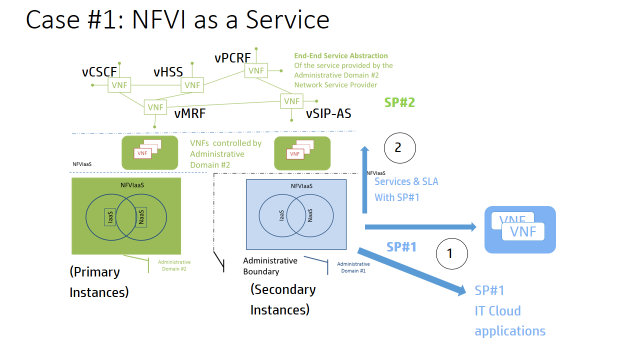
Fig 1. NFV Infrastructure as a service
Fig 1. highlights that some resources in the NFVI may be shared across Service Providers, while others may be dedicated. Access rights, policies, SLA, charging need to be carefully designed and monitored especially if combined with SDN and open programmatic access of the network paths to 3rd party Service Provider.
2.3 Actors and Layers in a Virtualized Network Infrastructure
Different actors can intervene in a fully virtualized network infrastructure, according to the use cases considered by the ETSI NFV ISG [3]
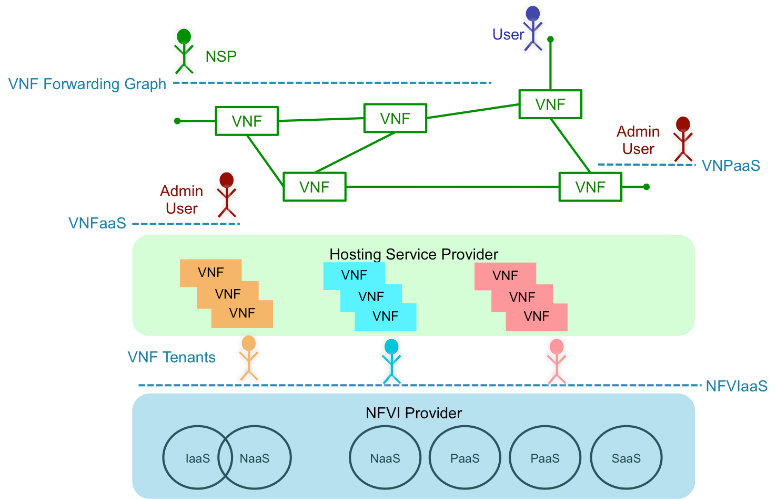
Fig 2. Actors in a virtualized network infrastructure
1) NFVI Providers offer the other actors access to datacentre and communication links that constitute the NFVI (NFV Infrastructure), mostly using the access models already described for the cloud, like IaaS and PaaS, but also for additional ones as well, as in the case of NaaS (Network-as-a-Service)
2) VNF Tenants run their Virtual Network Functions (VNFs) on top of the NFVI, and can provide these functions to potential users on an individual basis (VNFaaS), or together with additional tooling kits supporting higher-level integration and management (VNPaaS)
3) Admins in different enterprises integrate the VNFs into their network services, either for internal use or to actively provide them to third parties.
4) Network Service Providers assemble VNFs and attach them to a public network according to a VNF Forwarding Graph, creating a virtualised network service. In many cases, these services will imply the integration of virtualised and non-virtualised elements.
5) Finally, Users consume the services offered by NSPs or by their Admins.
Mixed scenarios, where a high level of integration is applied for certain kinds of functions, while other specialized ones are provided by specific tenants, are foreseeable as well.
Another important point is that any of the four degrees of freedom described above can be split into additional layers according to the state of the network infrastructure market, as well as to respond to regulatory changes.
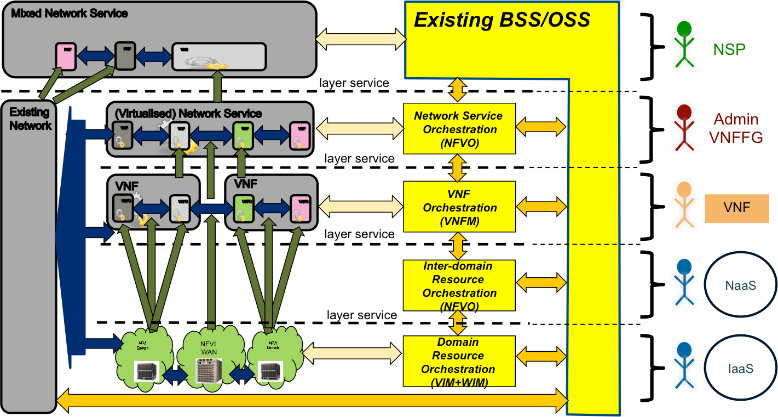
Fig 3. Split of service providers’ roles
Fig 3. shows a split with two different kinds of NFVI providers, one dealing with single-domain resources (computing, storage, local networks) and the other integrating them with long-haul network connections; the first provides essentially IaaS capabilities, while the second offers NaaS.
III. CONCLUSION
NFV and SDN provide the technology that enables new business models for network and service providers, creating new opportunities for both existing and new providers. New capabilities can also be introduced: more usage-based charging models, more granularity in the service capabilities, including security, privacy and location. NFV-SDN service catalogs and marketplaces could be created, along with roles for new actors such as service brokers or clearinghouse. Regulation may also evolve to enable these changes and to maintain some of the key principles of an open, transparent concurrent economy.
However, NFV and SDN also disrupt the vendor business model, moving from a silo proprietary vendor stack, primarily CAPEX and licensed-based model, to a more hybrid, multi-vendor model, with a mix of licensed and open source support-based models. The entry barrier to produce solutions will be much lower, with pure software based solutions and open source leverage, which will allow new, smaller vendors to compete with the incumbents. Standardization and automation will enable multiple combinations and more plug-and-play solutions with choices between on-premises, SaaS or hybrid models.
IV. REFERENCES
[1] White paper on “Software-Defined Networking: The New Norm for Networks” https://www.opennetworking.org/ ;
[2] White paper on “Network Functions Virtualisation”; http://portal.etsi.org/NFV/NFV_White_Paper.pdf NfV;
[3] “Network Functions Virtualisation (NFV); Use Cases” http://www.etsi.org/deliver/etsi_gs/NFV/001_099/001/01.01.01_60/gs_NFV001v010101p.pdf
 Diego Lopez received his MS from the University of Granada in 1985, and his PhD degree from the University of Seville in 2001. Diego joined Telefonica I+D in 2011 as a Senior Technology Expert on network infrastructures and services. He is currently in charge of research and standardization activities related to network infrastructures within the Global CTO Unit. He joined Telefónica in 2011 after several years in the academic sector. During this period he was appointed as member of the High Level Expert Group on Scientific Data Infrastructures by the European Commission, and as member of Internet2 MACE.
Diego Lopez received his MS from the University of Granada in 1985, and his PhD degree from the University of Seville in 2001. Diego joined Telefonica I+D in 2011 as a Senior Technology Expert on network infrastructures and services. He is currently in charge of research and standardization activities related to network infrastructures within the Global CTO Unit. He joined Telefónica in 2011 after several years in the academic sector. During this period he was appointed as member of the High Level Expert Group on Scientific Data Infrastructures by the European Commission, and as member of Internet2 MACE.
Diego is currently focused on identifying and evaluating new opportunities in technologies applicable to network infrastructures, and the coordination of national and international collaboration activities. His current interests are related to network infrastructural services, new network architectures, and network programmability and virtualization.
 Andy Reid is currently architect for BT’s project on network functions virtualisation. He is has been particularly concerned with removing packet performance bottlenecks in hypervisors and is now concerned with the operations and management on virtualised network functions and their supporting infrastructure platform. Andy has a long history in telecoms strategy and architecture and has a particular interesting in modelling, including functional modelling, data modelling, operational modelling, and performance modelling. In more recent years he has also done a substantial amount economic modelling for pricing, regulation and competition law.
Andy Reid is currently architect for BT’s project on network functions virtualisation. He is has been particularly concerned with removing packet performance bottlenecks in hypervisors and is now concerned with the operations and management on virtualised network functions and their supporting infrastructure platform. Andy has a long history in telecoms strategy and architecture and has a particular interesting in modelling, including functional modelling, data modelling, operational modelling, and performance modelling. In more recent years he has also done a substantial amount economic modelling for pricing, regulation and competition law.
 Antonio Manzalini received the M. Sc. Degree in Electronic Engineering from the Politecnico of Turin. In 1990 he joined CSELT, which then became Telecom Italia Lab. He started his activities on research and development of technologies and architectures for future optical transport networks: in this context, he chaired ITU-T Questions contributing to the development of several ITU-T Recommendations on transport networks (e.g., SDH, OTN). He has covered several leading roles in European Commission funded projects on future networks. He served as TPC member of several IEEE Conference, and recently he was co-General Chair of EuCNC2014. His results are published in more than 110 papers. He is currently joining the Strategy and Innovation Dept. of Telecom Italia (Future Centre) addressing strategic scenarios and innovation activities mainly related to Software Defined Networks, Network Function Virtualization, Internet of Things and 5G. He is Chair of the IEEE SDN initiative.
Antonio Manzalini received the M. Sc. Degree in Electronic Engineering from the Politecnico of Turin. In 1990 he joined CSELT, which then became Telecom Italia Lab. He started his activities on research and development of technologies and architectures for future optical transport networks: in this context, he chaired ITU-T Questions contributing to the development of several ITU-T Recommendations on transport networks (e.g., SDH, OTN). He has covered several leading roles in European Commission funded projects on future networks. He served as TPC member of several IEEE Conference, and recently he was co-General Chair of EuCNC2014. His results are published in more than 110 papers. He is currently joining the Strategy and Innovation Dept. of Telecom Italia (Future Centre) addressing strategic scenarios and innovation activities mainly related to Software Defined Networks, Network Function Virtualization, Internet of Things and 5G. He is Chair of the IEEE SDN initiative.
 Marie-Paule Odini holds a master's degree in electrical engineering from Utah State University. Her experience in telecom experience including voice and data. After managing the HP worldwide VoIP program, HP wireless LAN program and HP Service Delivery program, she is now HP CMS CTO for EMEA and also a Distinguished Technologist, NFV, SDN at Hewlett-Packard. Since joining HP in 1987, Odini has held positions in technical consulting, sales development and marketing within different HP organizations in France and the U.S. All of her roles have focused on networking or the service provider business, either in solutions for the network infrastructure or for the operation.
Marie-Paule Odini holds a master's degree in electrical engineering from Utah State University. Her experience in telecom experience including voice and data. After managing the HP worldwide VoIP program, HP wireless LAN program and HP Service Delivery program, she is now HP CMS CTO for EMEA and also a Distinguished Technologist, NFV, SDN at Hewlett-Packard. Since joining HP in 1987, Odini has held positions in technical consulting, sales development and marketing within different HP organizations in France and the U.S. All of her roles have focused on networking or the service provider business, either in solutions for the network infrastructure or for the operation.
Editor:
 Prof. Noël Crespi holds Masters degrees from the Universities of Orsay (Paris 11) and Kent (UK), a diplome d’ingénieur from Telecom ParisTech, a Ph.D and an Habilitation from Paris VI University (Paris-Sorbonne). From 1993 he worked at CLIP, Bouygues Telecom and then at Orange Labs in 1995. He took leading roles in the creation of new services with the successful conception and launch of Orange prepaid service, and in standardisation (from rapporteurship of IN standard to coordination of all mobile standards activities for Orange). In 1999, he joined Nortel Networks as telephony program manager, architecting core network products for EMEA region. He joined Institut Mines-Telecom in 2002 and is currently professor and Program Director, leading the Service Architecture Lab. He coordinates the standardisation activities for Institut Mines-Telecom at ITU-T, ETSI and 3GPP. He is also an adjunct professor at KAIST, an affiliate professor at Concordia University, and is on the 4-person Scientific Advisory Board of FTW (Austria). He is the scientific director the French-Korean laboratory ILLUMINE. His current research interests are in Service Architectures, Services Webification, Social Networks, and Internet of Things/Services.
Prof. Noël Crespi holds Masters degrees from the Universities of Orsay (Paris 11) and Kent (UK), a diplome d’ingénieur from Telecom ParisTech, a Ph.D and an Habilitation from Paris VI University (Paris-Sorbonne). From 1993 he worked at CLIP, Bouygues Telecom and then at Orange Labs in 1995. He took leading roles in the creation of new services with the successful conception and launch of Orange prepaid service, and in standardisation (from rapporteurship of IN standard to coordination of all mobile standards activities for Orange). In 1999, he joined Nortel Networks as telephony program manager, architecting core network products for EMEA region. He joined Institut Mines-Telecom in 2002 and is currently professor and Program Director, leading the Service Architecture Lab. He coordinates the standardisation activities for Institut Mines-Telecom at ITU-T, ETSI and 3GPP. He is also an adjunct professor at KAIST, an affiliate professor at Concordia University, and is on the 4-person Scientific Advisory Board of FTW (Austria). He is the scientific director the French-Korean laboratory ILLUMINE. His current research interests are in Service Architectures, Services Webification, Social Networks, and Internet of Things/Services.
http://noelcrespi.wp.tem-tsp.eu/
IEEE Softwarization - January 2016
IEEE Softwarization - January 2016
A collection of short technical articles
Rethinking Metro Networks
By Marc De Leenheer, Open Networking Lab; and Tom Tofigh, AT&T
To achieve network-wide programmability and observability, open source and vendor-agnostic interfaces are critical. We discuss the re-design of the metro network, demonstrate practical and scalable operational models, and introduce a disaggregated ROADM architecture.
SDN in the Cable Access Network
By Jeff Finkelstein, Cox Communications
With a Compound Annual Growth Rate approximately (CAGR) of 50% over the past few years we may extrapolate what our network consumption will become in the next ten years. At this pace we will outgrow capacity within cable TV head-end facilities. This will cause an increase in complexity, cost and operational impacts as we work to meet customer bandwidth demand. As service providers cable operators are concerned with managing the operational impact and cost associated with this dramatic increase in network requirements.
Impact of SDN/NFV on Business Models
Disruption and Opportunities
By Diego Lopez, Telefonica; Andy Reid, BT; Antonio Manzalini, Telecom Italia; and Marie-Paule Odini, HPE
This paper presents an analysis of the impact of Software Defined Networks and Network Function Virtualization on business models, primarily looking into Service Provider infrastructure and service offering evolution and eluding to some impact also for the vendor ecosystem.
SDN Initiative Creates Subcommittee to Address SDN, NFV Fragmentation
By Cagatay Buyukkoc, AT&T
The pre-industrial committee will analyze and evaluate potential methodologies, make recommendations and create industrial agreements, as well as look at opportunities and support Proof of Concepts around key technologies.




